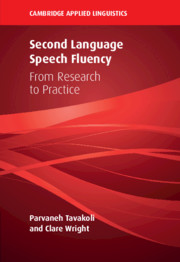Book contents
- Second Language Speech Fluency
- The Cambridge Applied Linguistics Series
- Second Language Speech Fluency
- Copyright page
- Dedication
- Contents
- Figures
- Tables
- 1 Introduction
- 2 Fluency from a Psycholinguistic Perspective
- 3 Measuring Fluency
- 4 Fluency in Second Language Task-Based Research
- 5 Fluency in Second Language Pedagogy
- 6 Fluency in Second Language Testing
- 7 Fluency in Different Contexts
- 8 Conclusion
- Appendix: Fluency Descriptors across Time
- References
- Author Index
- Subject Index
1 - Introduction
Published online by Cambridge University Press: 15 December 2020
- Second Language Speech Fluency
- The Cambridge Applied Linguistics Series
- Second Language Speech Fluency
- Copyright page
- Dedication
- Contents
- Figures
- Tables
- 1 Introduction
- 2 Fluency from a Psycholinguistic Perspective
- 3 Measuring Fluency
- 4 Fluency in Second Language Task-Based Research
- 5 Fluency in Second Language Pedagogy
- 6 Fluency in Second Language Testing
- 7 Fluency in Different Contexts
- 8 Conclusion
- Appendix: Fluency Descriptors across Time
- References
- Author Index
- Subject Index
Summary
The chapter provides the foundation for the whole book, discussing why fluency is an increasingly expanding area of research and an increasingly important subject for professionals in applied linguistics. We discuss current definitions and models of fluency, emerging from the growing body of second language fluency research. We present a reconceptualised multicomponent view of fluency taking more account of social interactional needs and real-world task demands, and highlight practical implications for pedagogy, assessment and language use.The chapter discusses two disconnects, firstly between different disciplines that should, in principle, be interested in and inform speech fluency research; secondly between research in L2 fluency and practice in applied linguistics, specifically in language teaching and language testing, and how these different domains emphasise fluency differently. We also identify limitations in current empirical investigation, so far dominated by research in English and European languages, and suggest that new research in non-European languages is needed to bring fresh insights into conceptualising, teaching and assessing fluency. We also argue that research into bilingual models of language can help us move to more meaningful ways of using bilingual norms as the basis for fluency development, rather than retaining a native-speaker goal for research and practice.
Keywords
- Type
- Chapter
- Information
- Second Language Speech FluencyFrom Research to Practice, pp. 1 - 21Publisher: Cambridge University PressPrint publication year: 2020
- 1
- Cited by

